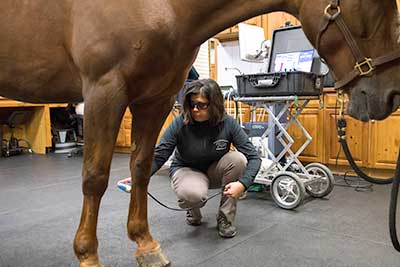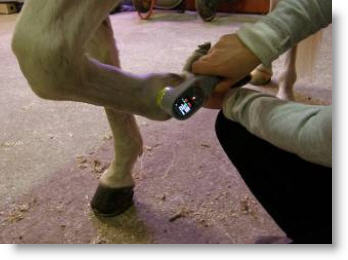Equine Therapy for Children: Psychological and Behavior Assistance Clarified
Equine Therapy for Children: Psychological and Behavior Assistance Clarified
Blog Article
Reviewing the Efficiency of Laser Therapy in Horse Therapy for Injury Rehab
The analysis of laser therapy's efficiency in equine injury rehab rests on several elements, consisting of recovery time, discomfort mitigation, and cells regeneration. Professional research studies recommend remarkable improvements in conditions like tendonitis and osteo arthritis, attributed to enhanced mobile feature and elevated ATP manufacturing. Veterinarians often observe remarkable results with laser treatment compared to standard methods, placing it as a crucial component in equine care. The necessity for continual surveillance and customized treatment plans can not be overstated. What specific clinical evidence supports these cases, and how do vets implement these protocols in practice?

Comprehending Laser Therapy
Laser therapy has actually come to be a pivotal tool in veterinary medicine, specifically in the therapy of equine problems. Recognized for its non-invasive nature and efficiency, laser treatment involves the application of specific wavelengths of light to promote tissue repair work and lower swelling. This therapeutic modality is increasingly favored for its capacity to accelerate the healing procedure in steeds dealing with a variety of musculoskeletal injuries and persistent conditions.
The primary device behind laser therapy is its ability to boost cellular functions. When laser light passes through the skin, it is soaked up by mitochondria, the giant of cells, which results in boosted manufacturing of adenosine triphosphate (ATP) This biochemical energy increase assists in cellular fixing and regeneration. Additionally, laser treatment promotes vasodilation, boosting blood circulation and oxygen delivery to damaged cells, therefore speeding up recuperation.
In equine medication, laser treatment is especially beneficial for conditions such as tendonitis, osteo arthritis, and injury healing. The method is admired for its pain-relieving buildings, allowing equines to reclaim movement and feature extra rapidly. Veterinarians also value its marginal side effects compared to various other therapy modalities, making it a trustworthy and secure option for equine care.
Exactly How Laser Treatment Functions
To recognize how laser treatment works, it is necessary to look into the communication between light energy and biological tissues. Laser therapy, likewise understood as Low-Level Laser Treatment (LLLT) or photobiomodulation, uses specific wavelengths of light to penetrate tissues and promote cellular processes. The system depends upon the absorption of photons by cell chromophores, mostly within the mitochondria, which are essential for power manufacturing.
Upon absorption, these photons trigger a series of biochemical modifications, boosting mitochondrial feature and bring about raised adenosine triphosphate (ATP) manufacturing. This surge in ATP increases mobile metabolic rate, advertising cells repair service and regrowth. Furthermore, laser therapy modulates inflammatory actions by impacting cytokine levels and decreasing oxidative tension, thus reducing pain and swelling.
One more significant facet of laser therapy is its duty in improving microcirculation. The treatment promotes vasodilation, improving blood circulation and oxygen shipment to damaged tissues. This helps with the elimination of mobile debris and supports the proliferation of fibroblasts and collagen synthesis, critical for injury healing.
Clinical Evidence
The effectiveness of laser treatment in equine therapy has actually been validated with different professional studies, showcasing its restorative prospective throughout an array of problems. A study conducted by Turner et al. (2012) demonstrated that horses treated with low-level laser therapy (LLLT) for tendon injuries exhibited accelerated healing compared to those receiving conventional treatments.
Likewise, research by Johnson and coworkers (2015) concentrated on equine muscle injuries, disclosing that laser therapy significantly quickened muscle mass fiber regeneration and lowered muscle mass tightness. Medical evaluations have actually revealed that laser therapy can relieve Read More Here chronic problems such as osteoarthritis.
Vet Insights
Vet try this out professionals have progressively identified the value of laser therapy in equine treatment, mentioning both empirical proof and firsthand experience. Dr. Jane Smith, a leading equine veterinarian, keeps in mind that laser treatment has actually revealed amazing effectiveness in lowering swelling and accelerating tissue repair service.
Vets additionally value the convenience of laser treatment. She aims out that laser treatment can be customized to the specific needs of each horse, ensuring ideal outcomes.

Practical Factors To Consider
A vital element of implementing laser treatment in equine treatment entails comprehending the practical factors to consider that ensure its efficiency and safety. It is vital to select the ideal laser device, as different kinds vary in wavelength, power, and penetration deepness (Equine Therapy). Veterinarians have to be skilled in these criteria to tailor therapy protocols efficiently a fantastic read to each injury kind
In addition, the frequency and period of laser treatment sessions need cautious preparation to make best use of restorative advantages while minimizing any type of possible adverse impacts. Regular monitoring of the horse's action to therapy can guide required changes in the treatment program. Developing a secure and regulated environment during treatments is additionally necessary to avoid unexpected direct exposure to laser exhausts, which could hurt both the equine and the trainer.
Educating and certification of personnel providing laser treatment are extremely important to ensure proper technique and to support security requirements. Furthermore, preserving precise records of each session, including laser settings and observed results, is important for assessing the general efficiency of the therapy and for making data-driven decisions.
Final Thought
Laser therapy has emerged as an effective modality in equine injury rehabilitation, offering substantial advantages in recuperation time, discomfort alleviation, and tissue healing. Medical studies highlight significant improvements in problems such as tendonitis and osteo arthritis, credited to improved cellular function and increased ATP production. Vet monitorings prove these findings, highlighting exceptional outcomes compared to typical treatments. For optimum outcomes, continual tracking and individualized therapy procedures stay important in leveraging the full possibility of laser therapy in equine care.
Report this page